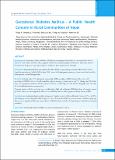Please use this identifier to cite or link to this item:
https://hdl.handle.net/20.500.14356/1707Full metadata record
| DC Field | Value | Language |
|---|---|---|
| dc.contributor.author | Thapa, P | - |
| dc.contributor.author | Shrestha, S | - |
| dc.contributor.author | Flora, M S | - |
| dc.contributor.author | Bhattarai, M D | - |
| dc.contributor.author | Thapa, N | - |
| dc.contributor.author | Mahat, B | - |
| dc.contributor.author | Pedersen, B S | - |
| dc.date.accessioned | 2023-05-19T05:30:48Z | - |
| dc.date.available | 2023-05-19T05:30:48Z | - |
| dc.date.issued | 2015 | - |
| dc.identifier.citation | ThapaP., ShresthaS., FloraM. S., BhattaraiM. D., ThapaN., MahatB., & PedersenB. S. (2016). Gestational Diabetes Mellitus – A Public HealthConcern in Rural Communities of Nepal. Journal of Nepal Health Research Council. https://doi.org/10.33314/jnhrc.v0i0.668 | en_US |
| dc.identifier.issn | Print ISSN: 1727-5482; Online ISSN: 1999-6217 | - |
| dc.identifier.uri | http://103.69.126.140:8080/handle/20.500.14356/1707 | - |
| dc.description | Original Article | en_US |
| dc.description.abstract | Abstract Background: Gestational Diabetes Mellitus (GDM) is in increasing trend recently. It is associated with adverse effects on both mother and fetus. Thus, diagnosis of GDM is an important public health issue. This study aimed todetermine the frequency of gestational diabetes mellitus in three rural districts of Nepal. Methods: A hospital based study was conducted in three districts representing mountain, hill and Terai belts ofNepal during the period of July 2009 to June 2010. A total of 564 pregnant women were interviewed and tested forblood glucose as per WHO guideline Results: In Nepal, only 2.5% of pregnant women had GDM according to WHO criteria while it was 6.6%according to IADPSG criteria. Overall mean blood glucose among pregnant women was 72.1 (fasting) and 95.8 (after2 hrs of 75 gm glucose intake) in which it was 62.8, and 75.1 in Dhading, 78.7 and 88.9 in Dhangadhi, and  98.3 and99.3 in Solukhumbu districts respectively.Pregnant women with increased age were significantly at high risk of having GDM than those of younger women(p=0.04). There were non-significant differences in GDM by District, Ethnic group and family history of DM. Conclusions: Gestational diabetes in the rural areas of Nepal is variable with two different criterias (2.5% vs 6.56%).Increasing age was an important influencing factor. Special attention should be given on women with increasing age.There was no significant difference in prevalence of GDM in three ecobelts of Nepal despite of altitude and culturalvariability. | en_US |
| dc.language.iso | en_US | en_US |
| dc.publisher | Nepal Health Research Council | en_US |
| dc.relation.ispartofseries | Sep-Dec, 2015;668 | - |
| dc.subject | Gestational diabetes mellitus | en_US |
| dc.subject | Risk factors | en_US |
| dc.subject | Rural nepalese women | en_US |
| dc.title | Gestational Diabetes Mellitus – A Public HealthConcern in Rural Communities of Nepal | en_US |
| dc.type | Journal Article | en_US |
| local.journal.category | Original Article | - |
| Appears in Collections: | Vol. 13 No 3 Issue 31 Sep-Dec 2015 | |
Files in This Item:
| File | Description | Size | Format | |
|---|---|---|---|---|
| 668-Article Text-1258-1-10-20160317.pdf | Full text Article | 183.39 kB | Adobe PDF |  View/Open |
Items in DSpace are protected by copyright, with all rights reserved, unless otherwise indicated.
